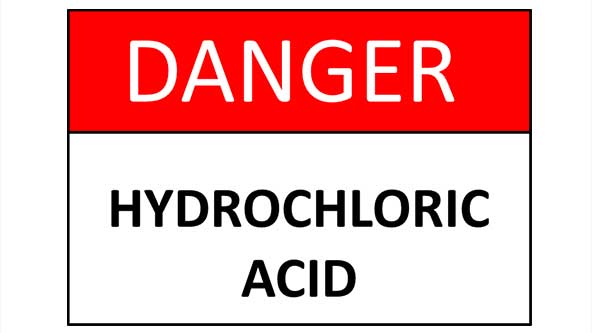Hydrochloric Acid Hazards & Safety Tips
Posted on September 10, 2014 | in Safety

What Exactly is Hydrochloric Acid & Where is it Found?
Hydrochloric acid hazards are serious. However, you may be surprised to learn that hydrochloric acid is commonly used in many types of industrial processes. Approximately 20 million tons of hydrochloric acid are produced globally each year, and you can even find it in your own home! These hydrochloric acid hazard safety tips can help you handle this toxic substance safely and appropriately, whether you encounter it at home or in the workplace.
Hydrochloric Acid and Uses & Attributes
Hydrochloric acid is a colorless to light yellow water-soluble liquid with a pungent, irritating odor. Produced as early as the 16th century, hydrochloric acid was historically known as “spirits of salt” and is sometimes called muriatic acid. It is used for a variety of purposes and is available at concentrations from 10 to 34 percent depending on its application. Hydrochloric acid is used for:
- Steel pickling
- Producing organic compounds (for PVC, activated carbon, ascorbic acid, and pharmaceuticals)
- Producing water treatment chemicals
- Regulating water pH
- Leather processing
- Salt purification
- Household cleaners
- Building construction
- Oil well acidizing
- Producing gelatin products
Hydrochloric Acid Hazards & Safety
Hydrochloric acid hazards are often severe, and it must be used with great care. Hydrochloric acid is corrosive, and concentrated forms often release acidic mists upon reaction with other substances that are also dangerous. If the acid or mist come into contact with the skin, eyes, or internal organs, the damage can be irreversible or even fatal in severe cases. The use of personal protective equipment is essential.
How to Handle Hydrochloric Acid Safely
Safety is of utmost importance when handling hazardous chemicals like hydrochloric acid. The Environmental Protection Agency regulates hydrochloric acid as a toxic substance, and it should be treated as such. It is recommended that you wear the following protective equipment when using hydrochloric acid of any concentration:
- Vapor respirator
- Rubber gloves
- Boots
- Full suit
- Face shields
If using hydrochloric acid at your workplace, it is highly recommended you have access to an eye-flush station in case of accidental exposure. You should also review all hydrochloric acid SDS information before handling.
If using cleaners containing hydrochloric acid in your home, always follow the label directions and safety instructions closely. It is usually recommended that you first dilute the cleaner to reduce its concentration. It is still important to wear protective clothing when using diluted acid, to ensure that it doesn’t come into contact with your skin, eyes, or mouth.
Proper Care for Hydrochloric Acid Exposure
Depending on the concentration of the hydrochloric acid you are working with, accidental exposure can occur as skin contact, eye contact, ingestion or inhalation of acidic vapors. Each of these types of exposure can pose serious hazards to your health and should be managed immediately.
Skin Contact – If hydrochloric acid comes into contact with your skin, flush immediately with plenty of water for at least 15 minutes, and remove any contaminated clothing. In case of serious skin contact, use water, a disinfectant soap, and anti-bacterial cream. Seek immediate medical attention.
Eye Contact – If hydrochloric acid or acidic mists get into your eyes, immediately flush with plenty of water for at least 15 minutes. Seek immediate medical attention.
Ingestion – If swallowed, do not induce vomiting. Seek immediate medical attention.
Inhalation – If you inhale hydrochloric acid fumes or mists, seek fresh air and medical attention immediately.
Hydrochloric Acid Storage and Disposal
Hydrochloric acid should be stored in a cool, dry, well-ventilated area away from sources of moisture. Always keep away from incompatible materials such as oxidizing agents, organic materials, metals and alkalis (basic compounds). Hydrochloric acid has the ability to corrode metallic surfaces. Keep container tightly closed and store in a safe place.
VelocityEHS Can Help!
Looking for hydrochloric acid hazard and safety information? Visit our VelocityEHS SDS Search page to quickly access safety data sheets (SDS) for the chemicals in your workplace. While you’re there, check out the Chemical Management capabilities of our Safety Solution, part of the VelocityEHS Accelerate® Platform. Our Chemical Management software capabilities will help you simplify the management of hazardous chemicals in your workplace including employee right-to-know access to SDSs from any mobile device, detailed workplace chemical inventory tracking, container labeling, and OSHA/EPA regulatory reporting, and much more!
Request a Demo today to see how easy GHS/HazCom compliance can be!